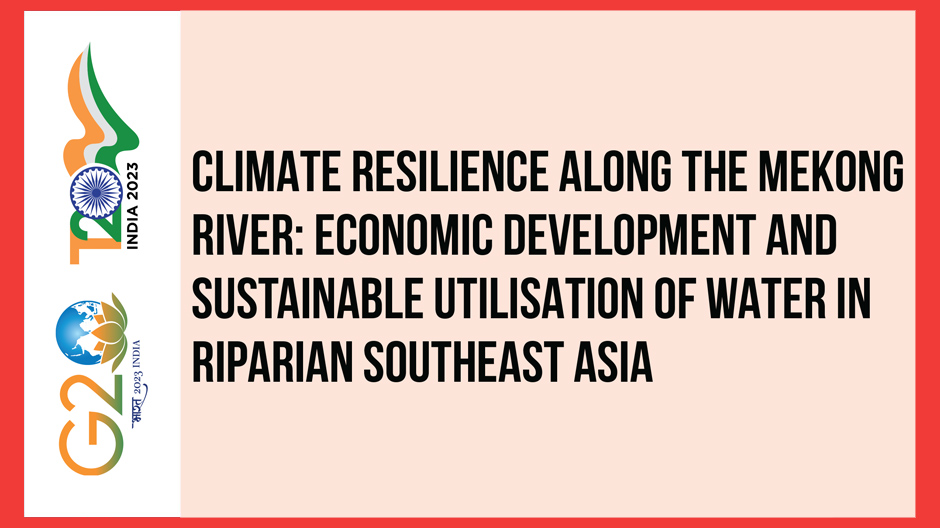TF-6: Accelerating SDGs: Exploring New Pathways to the 2030 Agenda
The Greater Mekong Subregion (GMS) includes Myanmar, Laos, Thailand, Cambodia, and Vietnam. It is a major regional trade route,[1] with millions relying on it for water, agriculture, and commerce.[2] As energy demand surges, riparian nations have begun exploiting their shared natural resources to meet their needs.[3] If resource overutilisation continues, it could create millions of climate refugees and destabilise the region by the end of the century. This policy brief recommends the creation of an international Mekong River resource commission, which will facilitate dialogue across the GMS, create buy-in for sustainable water utilisation, and promote information sharing.
1. The Challenge
With abundant natural resources and a growing role in the global economy, the Greater Mekong Subregion (GMS) countries have exhibited dynamic growth over the past few decades. As is true of the rest of the world, COVID-19 has transformed the region and served as a powerful reminder of its interconnectedness. Whilst the GMS was not immune to the sharp global economic contraction brought on by the pandemic, regional growth is expected to resume as global demand recovers in the coming years.
Over the past three decades, the GMS has witnessed growing industrialisation and urbanisation as both population levels and economic development have continued to mount. This maturation has begun to alter the composition of each country’s GDP, and, consequently, their key drivers of energy demand. The share of the GMS’ GDP attributed to industrial output has grown significantly since 1990, reaching 32.7 percent in 2020.[4] Industry’s expanding role has also materially contributed to the region’s electricity consumption per capita, which reached 3,093 kilowatt hours (kWh) per capita in 2020, up from 1,709 kWh per capita in 2010.[5]
Looking forward, prospects for economic recovery are optimistic, particularly as the GMS economies grow in importance to global supply chains. Although the GMS economies witnessed varying levels of the downturn across 2020 and 2021, with growth ranging from 4 percent to –18 percent, they have historically experienced robust growth of between 7 percent and 9 percent year-on-year from 2013 to 2019.[6] The reverberations of this strong economic growth have been felt in rising incomes across the region as GDP per capita increased to US$2,513 in 2020 from US$1,121 in 2000.[7]
With the GMS economies expected to recover further in 2023 and beyond, their governments must address the associated emissions concerns and the looming timelines they have set for decarbonisation. With the power sector playing a core role in contributing to emissions in the GMS (see Figure 1), reforms and steps taken toward decarbonisation must address power needs as a fundamental first step toward cross-sector decarbonisation. Greening the power sector will also create clear pathways for decarbonising other sectors, such as via the deployment of electric vehicles in the transport sector.
Figure 1: Greenhouse gas (GHG) emissions per capita (1990-2019) (LHS) and GHG emissions by sector (2019) (RHS)
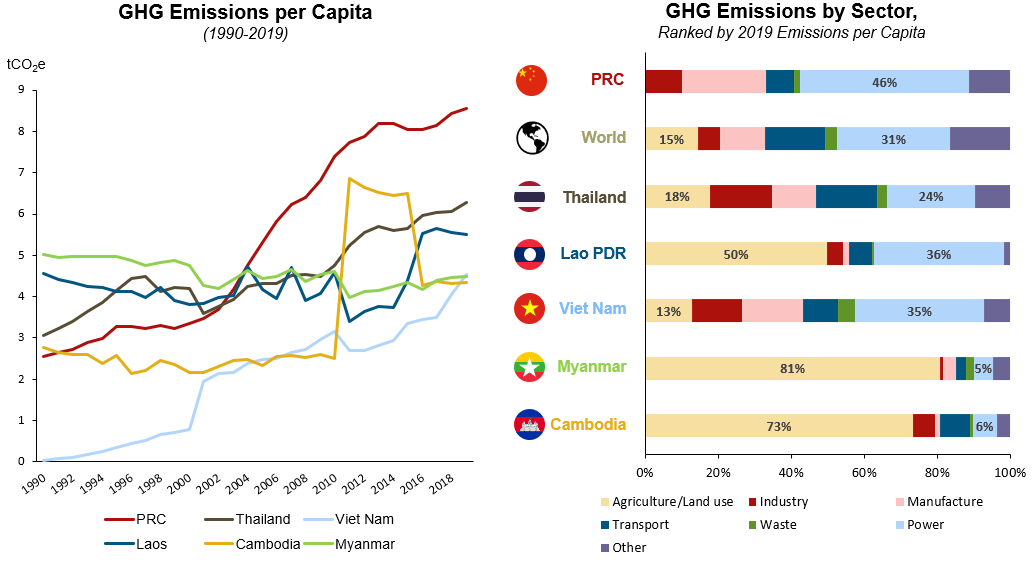
Note: Both graphs represent all GHG emissions as CO2 equivalent, inclusive of land use, land-use change, and forestry (LULUCF).
Source: World Bank[8]
The performances of the GMS economies have been mixed over the course of the COVID-19 pandemic (see Figure 2). Intra-subregion distinctions in economic contractions have resulted from differences in pandemic severity and management, tourism dependency, key industries, inflationary pressures, and domestic demand profiles. While forecasts agree that the worst of COVID-19’s impingement on the GMS is over and recovery has begun in most economies, economic growth is uneven and remains a concern. Several downside risks remain which include, rising inflation with recovering demand, spillover risk from global monetary tightening, and the global debt crisis. The challenge for each of the GMS countries will be in harnessing their respective high-growth sectors while ensuring that domestic resources are mobilised to establish sufficient fiscal space for resuming public sector development.
Responding to the COVID-19 pandemic, the GMS countries implemented a combination of lockdowns, curfews, and border closures to control the spread of the virus. These measures greatly disrupted economic activity and growth, with output contracting by 4.0 percent in 2020 in contrast to growth of 4.4 percent in 2019. Lockdowns significantly impacted manufacturing and production operations, while border closures severely affected tourism-dependent economies. The region’s governments used fiscal measures to mitigate the devastating effects of COVID-19 and countries belonging to the Association of Southeast Asian Nations (ASEAN) allocated an average of 0.4 percent of their GDP to support the health sector as well as a further 4.5 percent to help non-health sectors such as tourism and transport. Considering the economic diversity of the GMS, the area has seen a variety of measures to protect consumers from negative effects on the electricity sector.
Figure 2: The GMS countries annual real GDP growth (2000-2022) and forecast (2023)
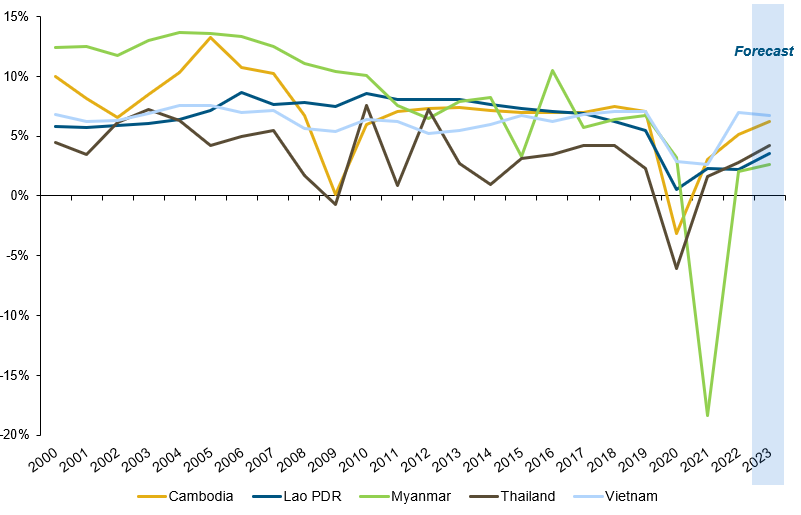
Source: Asian Development Bank[9]
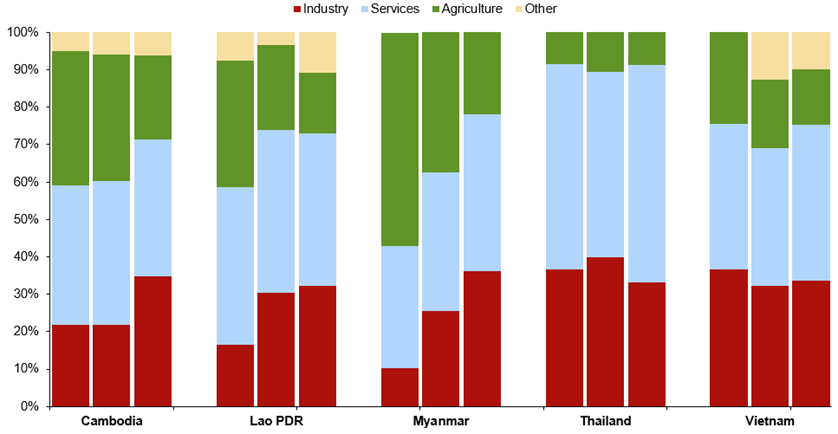
Source: World Bank[10]
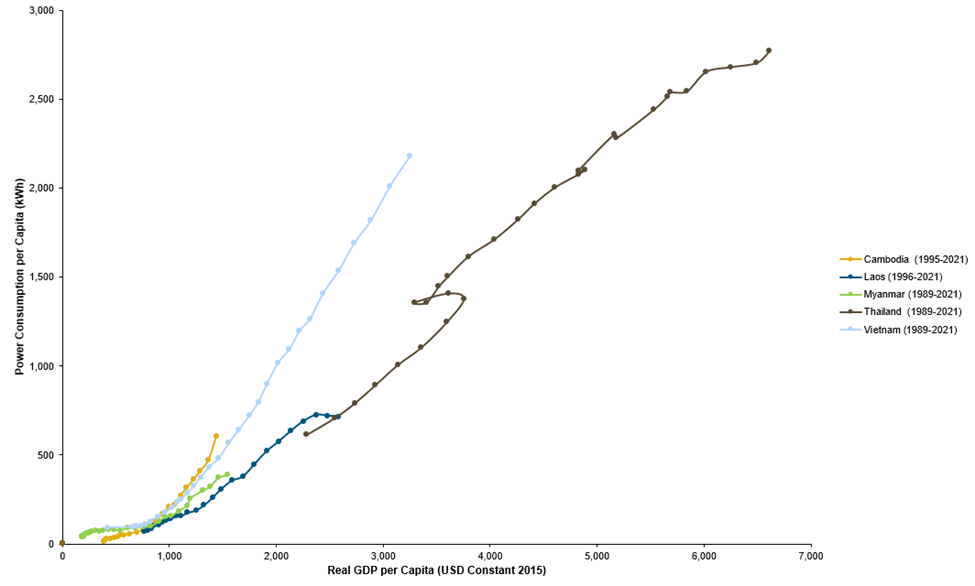
Source: World Bank[11]
Context
Transboundary water management is the future of sustainable water management and utilisation. However, more than half of all freshwater basins in the world lack international cooperation.[12] This is reflected globally as only 26 countries are signatories and 49 are party to the 1992 Convention on the Protection and Use of Transboundary Watercourses and International Lakes.[13] The 1997 Convention on the Law of the Non-Navigational Uses of International Watercourses has even fewer participants, with only 16 signatories and 37 countries as party to it.[14] 153 UN member states share waters, and naturally, cooperation when it comes to these international waterways is of universal importance. The scientific data is clear – as global water needs and climate change continue to escalate, there will likely be an increasing variability of water cycles.[15] This raises the risk of resource-derived conflict in the face of continuously growing water usage and economic need.[16]
If transboundary waterways are not managed properly through coordinated international efforts, the risks of not only international conflict, but inter and intrastate conflict is clear.[17] Conflicts between farmers, herders, and urban populations have erupted across the developing world, especially in Western Africa and the Sahel, where ongoing climate-derived factors have continued to escalate armed conflicts.[18]
60 percent of the world’s freshwater is in transboundary waterways, like the Mekong River. Freshwater is a rare and irreplaceable global common good. For the GMS, and the countries within it, it is even more important. 60 percent of Vietnamese water is in transboundary waterways.[19] Of the more than 65 million people living in the Lower Mekong River Basin, approximately 40 percent live within 15 km of the Mekong River, while most live within 5 km of the mainstream.[20] For many of them, the river is the regional highway that provides them with food security, livelihoods, and access to trade.
Despite its critical importance to the region, the Mekong River and its tributaries are facing an existential threat.[21] The lack of a legal infrastructure has created an atmosphere of unfettered competition as economic development continues to drive use of the GMS waterways to fuel agricultural and economic activities. Lack of water information sharing on top of excessive damming of the GMS rivers has led to enormous fluctuations in water levels and drought conditions during the wet seasons.[22] Shifts in financing towards self-financed infrastructure projects and the decline of international cooperation has raised the opportunity cost of investment for countries when working together on water. These factors are made more difficult to overcome due to the politics of the GMS and the greater Indo-Pacific region.
The asymmetrical power dynamic of ASEAN has led to a disproportionate power gap between the wealthier and more powerful maritime nations of ASEAN and their riparian partners.[23] This creates a cascading increase in agenda-driven regional cooperation on GMS transboundary management as the power gap within ASEAN is also nested within the great power tussle between China and the United States. However, should the underlying issues of uncoordinated water usage continue, the region faces the very real possibility of major droughts. This would result in a total collapse of food security for the region as the Mekong River alone produces 4.5 million metric tons of fish every year, about 80 percent of the protein consumed by the region.[24] This shock would greatly destabilise the GMS and result in a massive wave of climate refugees who will be displaced due to lack of water security.
2. The G20’s Role
The G20 is the perfect platform to solve this complex and multifaceted problem. As the preeminent forum for global economic coordination, representing 85 percent of the global GDP, over 75 percent of the global trade, and about two-thirds of the world population, the G20 must recognise that the GMS region is of vital importance to the international trade system. The Strait of Malacca alone transits roughly 40 percent of the world’s trade.
The economic might of the world’s largest economies could allow for the G20 to simultaneously tackle the issues of GMS transboundary water coordination at different levels. These cross-cutting issues could be taken up by the Sherpa track leaders to discuss problem solving across the Agriculture, Development, Disaster Risk Reduction, Education, Employment, Energy Transitions, Environment and Climate Sustainability, and the Trade and Investment working groups.
In terms of both availability of direct investments and mobilisation of private equity, the track leaders of the finance working groups could create the necessary impetus for massive restructuring of green investments. Thus, the G20 can provide the necessary capacity to tackle the financial and funding aspects necessary to create an environment of positive cooperation while also grounding financial coordination in smart, data driven policy development for natural resource conservation.
To overcome the political hurdles faced by the riparian nations of the GMS, the G20 could function as the ideal forum to start discussions between GMS nations and take the place of an unbiased arbiter in instances where grievance redressal and conflict resolution are needed. The G20 also wields enough political capital to work at both national as well as supranational levels with the GMS countries on the creation of the Mekong River Commission while negotiating with ASEAN. As the GMS encompasses five of the ten ASEAN countries with Indonesia being a member of the G20 and the current ASEAN Chair, it is in the G20’s interest to support the Southeast Asian region in its mission to become an epicentrum of growth and bringing peace and prosperity to the region. The establishment and support of this commission serves as a unique opportunity for the G20 and ASEAN to work together in an effort toto fortify the resilience and economic stability of the region. It also serves as a starting point from where both forums can identify potential collaboration areas, common interests, and future goals to better align their long-term agendas moving forward.
To summarise, the G20 provides not only the perfect cradle to give birth to a desperately needed Mekong River Commission, but can also supply the necessary economic, political, and human capital necessary to make the commission a strong, resilient, and durable agreement. The establishment of the commission would enable the advancement of Sustainable Development Goal11 (SDG) (sustainable cities and communities), SDG13 (climate action), and SDG17 (partnerships for the goals) in the GMS region. The creation of this commission could be instrumental in ensuring the economic, agricultural, and environmental viability of the GMS region for generations to come.
3. Recommendations to the G20
- This brief recommends the creation of an international Mekong River Commission to oversee and coordinate transboundary water management in the GMS and to ensure transparent water information sharing between all countries in the GMS. This organisation could help ensure proper climate resilience and preparedness for riparian nations in anticipation of future drought conditions.The authors recognise the vulnerability of our recommendation due to the lack of a national buy-in for regional cooperation, particularly about China’s involvement in over-damming the Himalayan snow melt waterways. However, shared water cooperation has historically been a driver of positive change between countries, even those in conflict-prone areas.[25] The Commissions of the Danube River and the Central Commission for the Navigation of the Rhine are concrete modern examples that have survived everything from regional competition to world wars.[26]Water is underutilised as a powerful peacebuilding and diplomatic tool. A “Cadence of Cooperation”, an ongoing continual effort towards cooperation and agreements, can jump-start a positive cooperation spiral where the costs and barriers to water cooperation are reduced, making room for deeper and stronger cooperation over time.
- To address the lack of a legal framework and atmosphere of competition, the authors recommend that all countries in the GMS sign and ratify the 1997 Convention on the Law of the Non-Navigational Uses of International Watercourses and the 1992 Convention on the Protection and Use of Transboundary Watercourses and International Lakes. These measures must be underpinned and strengthened at the local, national, regional, and global levels.Starting locally, horizontal-level consultation with water users is a necessity. To ensure the durability of initial agreements and nascent organisations’ success, decision-making processes involving consultation and problem-solving with all stakeholders (including women and civil society members) must be included. Going from the state level upwards, joint vulnerability assessments are needed to create a cohesive basin-wide adaptation strategy. These GMS basin-wide plans must agree on joint principles to facilitate adaptations at the national and regional levels.A transboundary river organisation must be created as a strong institution. As such, the organisation must ensure that adaptation needs are shared equally amongst members of the organisation and that all members are consulted on adaptation strategies to avoid tension or resentment. Transboundary management must be limited to the geographic area of the GMS.
- Adaptation to climate change requires knowledge and data sharing. This is especially important in the GMS as monitoring water levels and rain conditions must go beyond current conservation needs and focus on preservation. Using existing data tools such as the Mekong Dam Monitor[27] is essential in the vigilant data collection and management needed to assess the climate needs of the region properly.
- To address the lack of capacity and funding, this brief recommends enshrining safeguards for people’s lives and natural resources within the transboundary river organisation to ensure proper alignment regarding natural resource management and preservation. We also recommend working with climate-focused investment funds and organisations like the Global Climate Fund, which prioritises recipient country needs while focusing on sustainable development by providing concessionary funding to cover market failures.
- To support the longevity and sustainability of the Mekong River Commission, the participating countries should lean on three key pillars. First water literacy. By offering education that supports water-literate populations, countries will create an undercurrent for an intelligible policy and increase the local-level problem-solving abilities of their respective populations.[28] Second is the water economy. By equally distributing profits and adopting circular economic measures, the respective parties can create incentives to encourage transnational cooperation and higher levels of water utilisation.[29] Finally, the maintenance of water diplomacy. Participating countries must be equipped with an action-oriented toolbox which enables cooperation.[30] Such water diplomacy can be established and enabled by the commission itself while encouraging continuous and open communication between all member countries and stakeholders from different sectors. Adherence to these three pillars will facilitate long-term cost sharing, knowledge transfers, and better outcomes for all member states.
- To advance SDGs 11, 13, and 17, the Mekong River Commission could align with local, national, and regional GMS efforts. For SDG 11, the commission could make cities along the Mekong River safer and more resilient to climate change by helping to regulate river water levels and providing forewarning of flood or drought conditions. The commission could further make these cities more sustainable by empowering them to monitor and regulate energy, agricultural, and economic water utilisation. The inclusion of indigenous and underrepresented stakeholders in the commission, especially with regard to regional adaptation strategic planning, could also have the additional benefit of making the commission more inclusive and representative.The Mekong River Commission could also help advance SDG 13, as it will create an international legal framework for managing climate change impacts and build a robust financing pipeline within the region. It could also help with drought prevention efforts and work to maintain fully accessible, free-flowing freshwater reserves for the Indo-Pacific.Finally, SDG 17 could most effectively be advanced with the creation of a Mekong River Commission, as building partnerships is what SDG 17 ultimately seeks. The vertical integration of each country’s stakeholders could form the pillar on which multi-stakeholder partnerships and voluntary commitments could be built and improved. The integration of science and technology to monitor water data and create better climate outcomes could work to improve capacity development and knowledge sharing between all nations. In effect, this could improve the lives of each nation’s citizens and educate them on climate change by grounding their daily lives in applying climate-resilient practices.
Attribution: Aaron Chan, Jitsai Santaputra, and Tasia Matthew, “Climate Resilience Along the Mekong River: Economic Development and Sustainable Utilisation of Water in Riparian Southeast Asia,” T20 Policy Brief, September 2023.
[1] “The Mekong Matters for America and America Matters for the Mekong”, Stimson Center, 2020.
[2] “Greater Mekong,” World Wildlife Fund, accessed May 1, 2022.
[3] “Southeast Asia Energy Outlook 2019”, IEA, (2019).
[4] “Economic Statistics: Cambodia, China (Guangxi), China (Yunnan), Lao PDR, Myanmar, Thailand, Viet Nam”, December 1, 2004, via Bloomberg LP, accessed April 12, 2017.
[5] “World Bank Open Data.” N.d. World Bank Open Data: Population Total, and Electricity Consumption per Capita, Accessed October 6, 2022.
[6] “Economic Statistics: Cambodia, China (Guangxi), China (Yunnan), Lao PDR, Myanmar, Thailand, Viet Nam”, Bloomberg L.P. 2022, Accessed:1st May 2022
[7] “Economic Statistics: Cambodia, China (Guangxi), China (Yunnan), Lao PDR, Myanmar, Thailand, Viet Nam. December 1, 2004, via Bloomberg LP, accessed April 12, 2017.
[8] “World Bank Open Data.” n.d. World Bank Open Data Emissions per Capita, accessed October 6, 2022.
[9] “Asian Development Outlook (ADO) April 2023”, Asian Development Bank, 2023, accessed October 6, 2022.
[10] “World Bank Open Data,” n.d. World Bank Open Data, Gross Value Added to GDP for: Industry (including Construction), Services, and Agriculture, Forestry, and Fishing, accessed June, 22, 2022.
[11] “World Bank Open Data,” n.d. World Bank Open Data, Real GDP per capita vs. Power consumption per capita, accessed June, 22, 2022.
[12] “Transboundary Water Cooperation Coalition, Joint Statement of the Transboundary Water Cooperation Coalition on the Occasion of the UN 2023 Water Conference”, (United Nations, 2023).
[13] “Convention on the Protection and Use of Transboundary Watercourses and International Lakes,” United Nations Treaty Collection, accessed April 20,
[14] Convention on the Protection and Use of Transboundary Watercourses and International Lakes,” United Nations Treaty Collection, accessed April 20, 2023)
[15] Martina Sardo, Ilenia Epifani, Paolo D’Odorico, Nikolas Galli, and Maria Cristina Rulli, “Exploring the Water–Food Nexus Reveals the Interlinkages with Urban Human Conflicts in Central America,” Nature Water, no. 1 (2023): 348-358.
[16] Alexander Carius, Geoffrey D. Dabelkko, and Aaron T. Wold, “POLICY BRIEF: The United Nations and Environmental Security,” ECSP Report, no. 10 (2004): 60-66
[17] Marcus King, Weaponizing Water, (Boulder: Lynne Rienner Publishers, 2023), 1-214.
[18] “UN Warns of Worsening Conflict and Displacement in Sahel without Immediate Climate Action,” UNHCR, November 6, 2022.
[19] Quy-Nhan Pham, Ngoc-Ha Nguyen, Thi-Thoang Ta, and Thanh-Le Tran, “Vietnam’s Water Resources: Current Status, Challenges, and Security Perspective,” Sustainability 15, no. 8 (2023): 6441.
[20] “Mekong Basin,” Mekong River Commission, accessed April 20, 2023.
[21] Brian Eyler, Last Days of the Mighty Mekong, (London: Zed Books Ltd, 2019), 57-364.
[22] Mekong River Commission, “Mekong Low Flow and Drought Conditions in 2019-2021: Hydrological Conditions in the Lower Mekong River Basin,” (2022), Vientiane: Mekong River Commission.
[23] Cheng-Chwee Kuik, “Asymmetry and Authority: Theorizing Southeast Asian Responses to China’s Belt and Road Initiative,” Asian Perspective 45, no. 2 (2021): 255-276.
[24] “Mekong River at its lowest in 100 years, threatening food supply,” National Geographic, published July 31, 2019.
[25] “Policy Guidance Note on the Benefits of Transboundary Water Cooperation Identification, Assessment and Communication,” UNECE, accessed April 15, 2023.
[26] “International Water Cooperation Opens the Door to Peacemaking,” The MIT Press, published December 14, 2018.
[27] “Mekong Dam Monitor,” Stimson Center, accessed April 21, 2023.
[28] “Why Building Water Literacy Is More Important than Ever,” Australian Water Association, published January 24, 2020.
[29] SIWI, Making Water a Part of Economic Development: The Economic Benefits of Improved Water Management and Services, (Stockholm: Stockholm International Water Institute, 2005).
[30] “Water Diplomacy: Facilitating Dialogues,” SIWI, accessed April 11, 2023.



